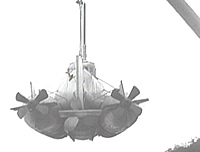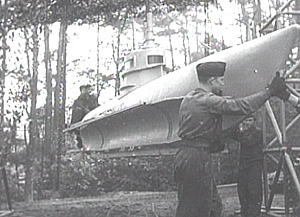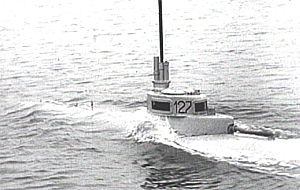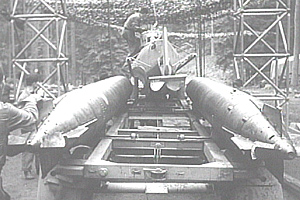PETER WIHTOL has written an article on the ‘Seehund’ which appeared in the SubCommittee Report, has an article on the ‘Biber’ as well as one on ‘accessories’, coming out in that publication. Photos sent by PETER out of Kriegsmarine and OSS Photos
THE BIBER
By Peter Wihtol
Reviewed and Edited by Enrico Doering
 This article is based upon a recently discovered POW interrogation report, obtained through the continuing and generous courtesy of Klaus Mattes. Historical edits and corrections were done by Enrico Doering. The translations between Enrico and I were done through the efforts and patience of his wife, Franziska Doering.
This article is based upon a recently discovered POW interrogation report, obtained through the continuing and generous courtesy of Klaus Mattes. Historical edits and corrections were done by Enrico Doering. The translations between Enrico and I were done through the efforts and patience of his wife, Franziska Doering.
These POW reports often are golden nuggets of original U-boat details. Their information will provide interesting background information for the serious model builder. Although not contained in this article, the original document also contains details of:
- Biber Operations in France and Holland;
- Organizational Details;
- Information about Biber Bases;
- Very minor additional information about Training.
When reading any WWII intelligence reports do remember that there was a war going on and that perfect intelligence reports were not intended so much as the rapid dissemination of reasonably accurate, useful information. POW interrogation reports often give highly useful information and provide valuable Allied guesstimations of what the enemy was doing. But in addition, you can also learn what was really concerning (worrying) US Naval intelligence at that time. Simply look at how many reports were written about a subject and what topics were covered the most and in the most detail in a single report. And of course the reverse: what they were not writing about and asking about.
Three types of information are presented in this article.
- Original intel information either taken directly from or paraphrased from the POW interrogation, intelligence report.
- [My own editorial comments or attempts at 20/20 hindsight clarifications, in brackets.]
- What was really happening on the German side of the big pond, additional comments (the final word, so to speak), edits, corrections, and historical clarifications were done by Enrico Doering and are presented in bold and italics. He is the author of Der nasse Tod, a WWII novel about the Biber. A family member of his was a Biber driver. Enrico has gathered an extensive-and-detailed collection of Biber history. Most of his information came from original German sources.
 OVERVIEW
OVERVIEW
The Biber was a one-man midget sub. It was the smallest WWII German U-boat. It’s new-and-improved features were: the ability to carry two torpedoes, a gasoline engine for greater range (100 nautical miles at 6.5 knots surfaced), and a periscope for a higher, better/further view over the waves.
THE TORPEDOES
had a reduced number of batteries so that the specific gravity for the torpedoes was close to zero. [This was necessary so not to permanently sink these midget submarines.] There was a reduction in torpedo speed and range (to about 20 knots and 5,000 yards). The reduction in range was less important because of the limited vision of the Biber crewman.
But each torpedo contained 600kg of dynamite and it still continued to be a dangerous weapon.
A GASOLINE ENGINE
was chosen for propulsion because many of the correct size were readily available. And at that time no appropriately sized diesels were available. However, with the gasoline engine there were problems with carbon monoxide poisoning and the potential for gasoline fume explosions.
 THE PERISCOPE.
THE PERISCOPE.
Its first problem was that, due to space constraints inside the conning tower, the driver could not see to the rear. One could only see forward and up to 40 degrees to the left and to the right. The second problem was that it was very difficult to maintain periscope depth – too many things needed to be done at one time to maintain control. The torpedoes could be fired when submerged but in practice the Biber always surfaced before firing torpedoes. Distance was difficult to estimate through the periscope. It was “point the boat and shoot.” The torpedoes on a captured Biber were preset to travel at a 10-foot depth. The periscope is secured to the air intake and the top is 4 ½ feet above the conning tower.
A fatal flaw of the Biber was that the drivers could not satisfactorily see behind. Only too late would they discover that the enemy (an RAF aircraft) was attacking them. Also the windows on the sides would often become covered with ice and the driver would be blind.
THE HULL
Design constraints (a small, lightweight boat carrying two torpedoes) produced a boat with a hull that was not very strong. The pressure hull was thinner. It was made of 3mm sheet steel giving a maximum operational diving depth of 20 meters. And the indentations for the two torpedoes also reduced depth charge resistance. There were fore and aft diving tanks but no trimming and compensating tanks. Solid ballast was loaded before the start of a mission and an attack could only be done while on the surface. To say that this boat was difficult to dive and control underwater is a gross understatement.
BIBER TECHNICAL DETAILS
 (Known by US Navy in 1944)
(Known by US Navy in 1944)
Length 29’ 9”
Weight 3 ½ tons w/o torpedoes. 6 ½ tons with torpedoes
Surfaced displacement with torpedoes 6 tons, estimated.
Fuel supply, 26 gallons gasoline.
Battery output 56 volts.
Surfaced speeds. Full speed: 7-8 knots. Cruising speed 5-6 knots. Half speed: 4 knots.
Submerged speed: 2-3 knots. The speed using electric motor on surface 4-5 knots.
Maximum diving depth 60’ according to crew. The depth gauge went to 25meters (82 feet)
Compressed air. 5 steel bottles of HP air stored at 200 atmospheres. They were 9 cubic feet volume in all and were used for blowing ballast tanks and operating the release rams for torpedoes.
Endurance. Maximum surfaced traveling time: .20-24 hours.
Maximum traveling time on batteries: 2-3 hours.
Maximum oxygen for the driver: 36 hours.
It could carry either 2 torpedoes or two mines or one of each. It was used for mine laying as well as firing torpedoes.
Conning tower was made of cast aluminum or aluminum alloy
Tanks Fore and aft diving tanks only.
The magnets for the projector compass were housed at the top of a sealed bronze-alloy tube, rigidly fixed through the forward end of the conning tower. It extends some 18” above and 12” below the deck.
There was a wooden rudder and single wooden hydroplane. These were controlled by two circular control wheels, one slightly smaller in diameter both turning on the same axis in front of the driver.
The air intake was originally 1’ above the conning tower, but this was increased to 3’ and was secured to the periscope. Like the Seehund the air drawn in goes through the crew area first and then to the engine. Therefore it also acts as a fresh air source for both the engine and the crewman.
Camouflage. In practice, the Biber was concealed in sheds and under trees; was also concealed by tarps & camouflage netting to obscure its shape when in the water tied next to the piers.
Training. This period was usually 2-3 weeks only. But this was only the first time (K-FL 261) in Feecàmp. The Biber training camp was known as Blaukoppel. It is near Schlutup, opposite the Flenderwerft, near Lübeck. It is three quarters of a mile from the nearest tramline and consists of wooden hutments.
The training period for a Biber driver was actually 8 weeks!
GENERAL REMARKS BY US NAVAL INTELLIGENCE
Its [the Biber’s] original purpose was for defense against invasion. It was not intended for offensive use in which they are now being used, hence their comparative lack of success. The Biber is an expendable weapon, to be used only once, and then blown up. It is not expected to return to home base after an operation. [If this were so, what would be the provisions for picking up the Biber crewmen?]
This is not completely right. There was a real chance for the drivers coming back after an action! At least that was so in the planning stage. For example, the Bibers had been towed on the sea in Holland to give them more fuel and thus improve their chances for return.
As a result of trials in the Baltic, it was concluded [by the Germans?] that neither hydrophone nor asdic would prove effective against [in detecting] the Biber.
MANEUVERABILITY, SUBMERGING AND SURFACING
In a complicated maneuver it requires great skill to handle the hydroplane and rudder simultaneously and at the same time observe the compass, depth gauge and periscope. Biber proceed almost entirely on the surface, and submerge when it is absolutely necessary. They occasionally lie on the bottom. When tanks are blown after lying on the bottom, Biber are liable to shoot to the surface very quickly.TOWING TRIALS
of Biber using the smaller explosive motorboats and the larger torpedo boats have not been successful. [The explosive motor boats and torpedo boats have hull forms and propellers designed for optimum performance at higher, planing speeds. Those hull/propeller combinations attempting to drag one or more Bibers would have been a terrible choice. Towing was done, apparently more successfully, using tug boats.]
After training in the Baltic, Bibers had been transported by the usual submarines (Type VIIC), one Biber being in front of the conning tower and another behind. In that way there was one action conducted with three subs (i.e. six Bibers). They were expected to attack ships near Murmansk. This was supposed to be “Operation Cäsar.”
THE LESS PLEASANT, PERSONAL DETAILS (A “KLINKER-FREE DIET” AND WORSE)
[For the unenlightened reader, there was no toilet aboard WWII German midget U-boats and manned torpedoes. Biber sorties would last from 1-2 days. And the later, Seehund sorties would usually last up to about five days – but one went 10 days.] Before sailing, Biber crewmen received a special, [low-bulk or “klinker-free”] diet: [then, when on their mission] they were instructed that during the first 24 hours they must use food tablets; thereafter energy tablets, which will keep a man going for another 24 hours. Many Biber crew suffer from seasickness and, owing to the danger of water entering when the hatch is opened, have vomited into the bilge. [This latter unpleasantness must be mentioned because the first symptom of nausea from CO poisoning feels just like being seasick. But with CO poisoning, confusion, unconsciousness, and death soon follows.]
Not all of the Biber drivers (but most) had been driving submarines before. Many of them were volunteers having served in different units of the German Navy. It’s correct that the drivers got some “food-tablets.” But “doping” was only an experiment (D-IX tablets were a combination of Pervitin, Kodain and Eukodal).* To avoid tiredness they ate “Schoka-Kola”** a type of chocolate, tasting like Cola.
[*D-IX was a “drug cocktail” of amphetamines or uppers, cocaine, and a morphine or codeine-like drug. Tests showed that, with heavy physical activity, this initially produced euphoria but exhaustion would occur in about one-to-three days – depending upon the amount of physical activity done. Later, volunteer Seehund drivers were given just Pervitin (uppers) and after several days of use, hallucinations were common. Most Seehund drivers did not want to use this drug. Its use was optional.
**This (Skoka-Kola) is still available as a consumer product today, having 52.5% cocoa, 0.2% caffeine and I guess that the balance being mostly sugar.]
From Harry Cooper: This was a very interesting article, based on a submarine Type that we usually don’t read about. Many thanks PETER; we look forward to more articles from you on the small submarines. We also would encourage other Members to research and write articles for our KTB Magazine.
And to Members like GERRY RICHTER (214-LIFE-1986) who actually drove the small U-Boats, we’d like your memories too.
Sneak Craft: German Biber Mini-Submarines
Sneak Craft: U-5075 Hund Mini-Sub
Sneak Craft: U-Boat Accessories 1944
Back to KTB # 170 Table of Contents
Back to KTB List of Issues
Back to MagWeb Master Magazine List
© Copyright 2003 by Harry Cooper, Sharkhunters International, Inc.
This article appears in MagWeb.com (Magazine Web) on the Internet World Wide Web. Other articles from military history and related magazines are available at http://www.magweb.com
Join Sharkhunters International, Inc.: PO Box 1539, Hernando, FL 34442, ph: 352-637-2917, fax: 352-637-6289, www.sharkhunters.com
